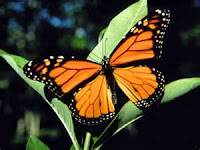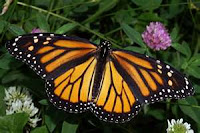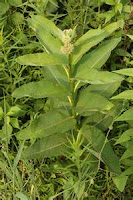Raising Monarch Butterflies
Raising Monarch butterflies is a great family summer activity and very easy.Monarchs' spring arrival from Mexico in the Midwest is weather dependent, some years they will appear in mid-May, other years in early June. They will reproduce for 3 to 4 generations during the summer. The life span of all of these generations, except for the last one, is 4-8 weeks. The last generation will migrate to Mexico at the end of August and will have a life span of 8-9 months. This group will start the long migration north again in the spring.
Monarchs only reproduce on milkweed plants. You can find milkweeds in meadows and parks. I usually see them right along the edge of the long meadow grass where it meets the cut grass of a park or along a roadway. Vacant lots in office parks are another place to spot them.
Butterflies typically lay their eggs underneath the leaf, but many times we do find them right on top. The egg stage is 3-5 days. You can pick the leaf that the egg is on.
Once the caterpillar hatches, it only needs Milkweed plants to survive. In the same place you found your egg, cut off the top 1/3 of the Milkweed plant. Before you put it in a narrow neck vase, recut the stem because the "milk" will start to seal the end immediately when you cut it, preventing it from properly taking in water. When the milkweed starts to die in a few days, simply cut a new plant and put it in the container. The caterpillars will smell the new fresh leaves and climb over.
Monarch caterpillars are voracious eaters! You and your kids will be amazed at how fast the microscopic caterpillar from day 1 grows to a 2 inch long one on day 20. These caterpillars grow so fast and large that if a human grew at the same rate, we would be the size of the Empire State Building! If you have many in your aquarium, when they are in their last week of growth you can actually hear them eating. A large caterpillar will eat over 1 full leaf per day. That would be like me eating something the size of my living room floor. Needless to say, what goes in must come out, usually all happening at the same time. Your aquarium will get messy and need cleaning from time to time.
Caterpillars go through 5 growth stages. You will notice this if you see it just sitting on the side of your aquarium for hours. It is preparing to molt. It will shed it's skin and then eat it before heading back to the plant.
When it is ready to turn into a chrysalis, it will head to the top of the aquarium or to a stick or plant and spend part of the day making it's base to hold onto. Do not disturb it at this point, the cycle can't be interrupted or it will die. When the base is finished it will then attach itself to the base with it's back end. On a microscope it looks like velcro hooks attached to the loops of the base. Now the caterpillar will hang in a "J". It will stay this way for about 12 hours and then shed it's last layer of skin to form a chrysalis. It is a misnomer to say they spin a cocoon, the chrysalis is actually part of their body, a thin layer of skin to protect them as they change into a butterfly.
To see the chrysalis form is amazing. Just before it happens, the J will be very droopy as well as the antennae. The skin will start to split at the back of the head. Very soon it will start to split all the way up the back and the caterpillar will be wiggling very hard to move the skin up it's body.
It will be in the chrysalis stage for 10-14 days. If you look closely you can see the shape of the wings through the chrysalis. When the butterfly is close to hatching, the outer layer will be clear and you can see the butterfly inside. Butterflies hatch in the morning, they will crawl out of the chrysalis and the wings will be tiny and wrinkled. It will spend a few minutes stretching it's wings. At this point it will also relieve itself, it's been holding it for almost 2 weeks so it will be a lot. The butterfly won't be able to fly for about 4 hours. You can hold it by nudging it off the leaf or stick with 1 finger underneath the feet. Do not touch the wings, you will damage them. When taking it outside, if it doesn't fly right away you can place it on the trunk of a tree or on a tall plant.
You can tell if your butterfly is a boy or a girl. Boys have a small dot on either side of the lower wing.
 |
| Male |
 |
| Female |
Tips:
-I keep my caterpillars in an aquarium with a screen cover.
-They need good ventilation, so make sure the cover has a screen, not just a few air holes.
-You can put a stick or 2 in the aquarium for them to make their chrysalis on, but most will just go to the top.
-No water! They get their water from the plant itself, the only water in the aquarium should be in the vase for the plants.
-I keep a clippers and a thick piece of paper in the car to cut and transport the milkweed plants. Milkweeds will drip "milk" when cut. It is sticky and can stain the carpet in your car. I lay them down so the end drips on the paper.
-It is difficlut to keep the butterflies, their food needs are much more complicated. It is best to release them so they can reproduce.
For more sources visit: www.monarchwatch.org or www.livemonarch.com
-It is difficlut to keep the butterflies, their food needs are much more complicated. It is best to release them so they can reproduce.
For more sources visit: www.monarchwatch.org or www.livemonarch.com








